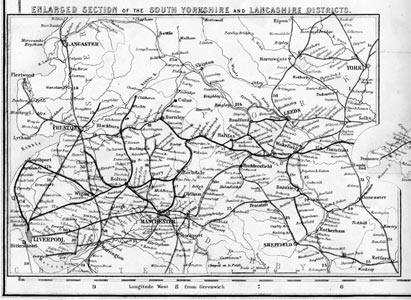|

NOTES ON ISSUE 10: HISTORICAL GLOSSARY
PART 1 OF 2
Printable View
"after
his beloved father died, when he was eight years old, his mother,
too, could pinch a bit, as it was her duty and her pleasure
and her pride to do it, to help him out in life, and put him
'prentice."
In other words, as a young boy Bounderby was sent to work as an apprentice, a common means of training less-well-off children to a useful trade. (Recall that early in the novel, Bounderby and Gradgrind asked why Sissy Jupe had not been apprenticed.) Apprenticeships were also common in some of the professions; lawyers and doctors, for instance, underwent apprenticeships for their training. Parents wishing to apprentice their children had to find a master for them and sign a contract stating that the child was "articled" (bound) to the master, who received a fee. The child then usually lived and worked with the master for a period of at least seven years. It is not clear here what trade Bounderby was learning.
"though his mother kept but a little
village shop, he never forgot her, but pensioned me on thirty
pound a year—more than I want, for I put by out of it"
Compare this small pension—barely more than half a pound a week—to Mrs. Sparsit's salary of £100 per year. To live on this sum and put some money aside, Mrs. Pegler must be extremely frugal or else must still earn some small income from her shop.
As Coketown cast ashes not only
on its own head but on the neighbourhood's too—after the manner
of those pious persons who do penance for their own sins by
putting other people into sackcloth
The image of the ashes here is taken from the Catholic custom (also practiced among High Church members of the Church of England) of sprinkling ashes on the heads of those who have confessed on Ash Wednesday, at the beginning of Lent. The aside concerning putting other people into sackcloth is most likely a sly jab at strict Sabbatarians, who sought to put a stop to all amusements on Sundays as well as to railroad travel on Sunday.
It was customary for those who now
and then thirsted for a draught of pure air, which is not absolutely
the most wicked among the vanities of life, to get a few miles
away by the railroad, and then begin their walk
Weekend "excursion trains," which were quite inexpensive, were very popular in the industrial areas so that workers could get to the countryside on their one day off per week, Sunday. Manchester and other industrial towns, though highly urbanized at this period, were nevertheless surrounded by pretty and much cleaner countryside. This railway map of South Yorkshire and Lancashire shows the extent of the open country surrounding the great cities, as well as the railroad connections and spur lines in the area.

Click
on image for larger view
Mounds where the grass was rank
and high, and where brambles, dock-weed, and such-like vegetation,
were confusedly heaped together, they always avoided, for dismal
stories were told in that country of the old pits hidden beneath
such indications.
The industrial areas in the north of
England, as well as the midlands, had been heavily used as mining
areas and were dotted with old, disused mines, many of them
unmarked or poorly indicated. As Rachael and Sissy know—and
as we see all too clearly in the course of the chapter—these
deep, disused mine shafts could be extremely dangerous. On April
15, 1843, the Illustrated London News published this
illustration of a mine shaft that was still in use. Note how
the light just barely filters down, indicating that the vertical
shaft is quite deep.

a candle was sent down to try
the air
One of the many dangers of mining was
that poisonous gases could collect in underground shafts. Sending
a candle down the shaft tested for the presence of oxygen. If
the candle stayed lit, then breathable air was present. However,
since some of these gases were combustible (as in the later
reference to "fire-damp," safety lamps were used for
lighting in the mines.
"I ha' fell into th' pit, my
dear, as have cost, wi'in the knowledge o' old fo'k now livin',
hundreds and hundreds o' men's lives…. I ha' fell into a pit
that ha' been wi' the' fire-damp crueler than battle. I ha'
read on ‘t in the public petition, as onnyone may read, fro'
the men that works in pits, in which they ha' pray'n and pray'n
the lawmakers for Christ's sake not to let their work be murder
to ‘em…"
Fire-damp, a combustible gas, caused
deadly explosions in coal mines. Stephen here refers to the
movement in the 1840s, which Dickens had strongly and publicly
supported, to improve safety measures in coal mines. Dickens
also referred to mining safety in several Household Words
articles.
|

